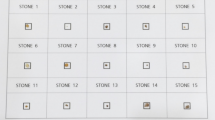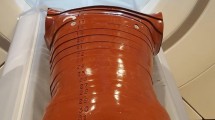Abstract
Objectives
To predict the main component of pure and mixed kidney stones using dual-energy computed tomography and machine learning.
Methods
200 kidney stones with a known composition as determined by infrared spectroscopy were examined using a non-anthropomorphic phantom on a spectral detector computed tomography scanner. Stones were of either pure (monocrystalline, n = 116) or compound (dicrystalline, n = 84) composition. Image acquisition was repeated twice using both, normal and low-dose protocols, respectively (ND/LD). Conventional images and low and high keV virtual monoenergetic images were reconstructed. Stones were semi-automatically segmented. A shallow neural network was trained using data from ND1 acquisition split into training (70%), testing (15%) and validation-datasets (15%). Performance for ND2 and both LD acquisitions was tested. Accuracy on a per-voxel and a per-stone basis was calculated.
Results
Main components were: Whewellite (n = 80), weddellite (n = 21), Ca-phosphate (n = 39), cysteine (n = 20), struvite (n = 13), uric acid (n = 18) and xanthine stones (n = 9). Stone size ranged from 3 to 18 mm. Overall accuracy for predicting the main component on a per-voxel basis attained by ND testing dataset was 91.1%. On independently tested acquisitions, accuracy was 87.1–90.4%.
Conclusions
Even in compound stones, the main component can be reliably determined using dual energy CT and machine learning, irrespective of dose protocol.
Key Points
• Spectral Detector Dual Energy CT and Machine Learning allow for an accurate prediction of stone composition.
• Ex-vivo study demonstrates the dose independent assessment of pure and compound stones.
• Lowest accuracy is reported for compound stones with struvite as main component.


Similar content being viewed by others
Abbreviations
- CI:
-
Conventional images
- CT:
-
Computed tomography
- CTDIvol :
-
Volumetric computed tomography dose index
- DSCT:
-
Dual source computed tomography
- LD1/2 :
-
Low dose acquisition 1/2
- ML:
-
Machine learning
- ND1/2 :
-
Normal dose acquisition 1/2
- NN:
-
Neural networks
- ROC:
-
Receiver operator characteristics
- ROI:
-
Region of interest
- SDCT:
-
Spectral detector computed tomography
- UA:
-
Uric acid
References
Khan SR, Pearle MS, Robertson WG et al (2016) Kidney stones. Nat Rev Dis Primers 53:16008. https://doi.org/10.1038/nrdp.2016.8
Nestler T, Haneder S, Große Hokamp N (2018) Modern imaging techniques in urinary stone disease. Curr Opin Urol 1. https://doi.org/10.1097/MOU.0000000000000572
Miernik A, Hein S, Wilhelm K, Schoenthaler M (2017) Urinary stone analysis - what does the future hold in store? Aktuelle Urol 48:127–131. https://doi.org/10.1055/s-0042-120468
Pearle MS, Goldfarb DS, Assimos DG et al (2014) Medical management of kidney stones: AUA Guidelines 1–26
Chang D-H, Slebocki K, Khristenko E et al (2019) Low-dose computed tomography of urolithiasis in obese patients: a feasibility study to evaluate image reconstruction algorithms. Diabetes Metab Syndr Obes 12:439–445. https://doi.org/10.2147/DMSO.S198641
Tiselius HG, Ackermann D, Alken P, Buck C, Conort P, Gallucci M (2014) Pocket guidelines on urolithiasis. Eur Urol 40:362–371. https://doi.org/10.1159/000049803
Zheng X, Liu Y, Li M, Wang Q, Song B (2016) Dual-energy computed tomography for characterizing urinary calcified calculi and uric acid calculi: a meta-analysis. Eur J Radiol 85:1843–1848. https://doi.org/10.1016/j.ejrad.2016.08.013
Große Hokamp N, Salem J, Hesse A et al (2018) Low-dose characterization of kidney stones using spectral detector computed tomography: an ex vivo study. Invest Radiol 53:457–462. https://doi.org/10.1097/RLI.0000000000000468
Hidas G, Eliahou R, Duvdevani M et al (2010) Determination of renal stone composition with dual-energy CT: in vivo analysis and comparison with x-ray diffraction. Radiology 257:394–401. https://doi.org/10.1148/radiol.10100249
Eiber M, Holzapfel K, Frimberger M et al (2012) Targeted dual-energy single-source CT for characterisation of urinary calculi: experimental and clinical experience. Eur Radiol 22:251–258. https://doi.org/10.1007/s00330-011-2231-2
Wilhelm K, Schoenthaler M, Hein S et al (2015) Focused dual-energy CT maintains diagnostic and compositional accuracy for urolithiasis using ultralow-dose noncontrast CT. Urology 86:1097–1102. https://doi.org/10.1016/j.urology.2015.06.052
Manglaviti G, Tresoldi S, Guerrer CS et al (2011) In vivo evaluation of the chemical composition of urinary stones using dual-energy CT. AJR Am J Roentgenol 197:76–83. https://doi.org/10.2214/AJR.10.5217
Boll DT, Patil NA, Paulson EK et al (2009) Renal stone assessment with dual-energy multidetector CT and advanced postprocessing techniques: improved characterization of renal stone composition--pilot study. Radiology 250:813–820. https://doi.org/10.1148/radiol.2503080545
Stolzmann P, Leschka S, Scheffel H et al (2010) Characterization of urinary stones with dual-energy CT: improved differentiation using a tin filter. Invest Radiol 45:1–6. https://doi.org/10.1097/RLI.0b013e3181b9dbed
Spek A, Strittmatter F, Graser A, Kufer P, Stief C, Staehler M (2016) Dual energy can accurately differentiate uric acid-containing urinary calculi from calcium stones. World J Urol 34:1297–1302. https://doi.org/10.1007/s00345-015-1756-4
Ilyas M, Dev G, Gupta A, Bhat TA, Sharma S (2017) Dual-energy computed tomography: a reliable and established tool for in vivo differentiation of uric acid from nonuric acid renal stones. Niger Postgrad Med J 25:52–59. https://doi.org/10.4103/npmj.npmj_24_18
Bi WL, Hosny A, Schabath MB et al (2019) Artificial intelligence in cancer imaging: clinical challenges and applications. CA Cancer J Clin 69:127–157. https://doi.org/10.3322/caac.21552
Soffer S, Ben-Cohen A, Shimon O, Amitai MM, Greenspan H, Klang E (2019) Convolutional neural networks for radiologic images: a Radiologist’s guide. Radiology 180547. https://doi.org/10.1148/radiol.2018180547
Pinto dos Santos D, Baeßler B (2018) Big data, artificial intelligence, and structured reporting. Eur Radiol Exp 2:10–14. https://doi.org/10.1186/s41747-018-0071-4
Hosny A, Parmar C, Quackenbush J, Schwartz LH, Aerts HJWL (2018) Artificial intelligence in radiology. Nat Rev Cancer 18:500–510. https://doi.org/10.1038/s41568-018-0016-5
Dreyer KJ, Geis JR (2017) When machines think: Radiology’s next frontier. Radiology 285:713–718. https://doi.org/10.1148/radiol.2017171183
Rajiah P, Abbara S, Halliburton SS (2017) Spectral detector CT for cardiovascular applications. Diagn Interv Radiol 23:187–193. https://doi.org/10.5152/dir.2016.16255
Große Hokamp N, Hellerbach A, Gierich A et al (2018) Reduction of Artifacts caused by deep brain stimulating electrodes in cranial computed tomography imaging by means of virtual Monoenergetic images, metal Artifact reduction algorithms, and their combination. Invest Radiol 53:424–431. https://doi.org/10.1097/RLI.0000000000000460
Blackledge MD, Collins DJ, Koh D-M, Leach MO (2016) Rapid development of image analysis research tools: bridging the gap between researcher and clinician with pyOsiriX. Comput Biol Med 69:203–212. https://doi.org/10.1016/j.compbiomed.2015.12.002
van Hamersvelt RW, Willemink MJ, de Jong PA et al (2017) Feasibility and accuracy of dual-layer spectral detector computed tomography for quantification of gadolinium: a phantom study. Eur Radiol 27:3677–3686. https://doi.org/10.1007/s00330-017-4737-8
Sellerer T, Noël PB, Patino M et al (2018) Dual-energy CT: a phantom comparison of different platforms for abdominal imaging. Eur Radiol. https://doi.org/10.1007/s00330-017-5238-5
Ananthakrishnan L, Duan X, Xi Y et al (2018) Dual-layer spectral detector CT: non-inferiority assessment compared to dual-source dual-energy CT in discriminating uric acid from non-uric acid renal stones ex vivo. Abdom Radiol (NY) 43:3075–3081. https://doi.org/10.1007/s00261-018-1589-x
Scott Kriegshauser J, Naidu SG, Paden RG, He M, Wu Q, Hara AK (2015) Feasibility of ultra-low radiation dose reduction for renal stone CT using model-based iterative reconstruction: prospective pilot study. Clin Imaging 39:99–103. https://doi.org/10.1016/j.clinimag.2014.10.013
Kriegshauser JS, Paden RG, He M et al (2017) Rapid kV-switching single-source dual-energy CT ex vivo renal calculi characterization using a multiparametric approach: refining parameters on an expanded dataset. Abdom Radiol (NY). https://doi.org/10.1007/s00261-017-1331-0
Assimos D, Krambeck A, Miller N et al (2016) Surgical Management of Stones: American Urological Association/Endourological Society Guideline. J Urol 196:1153–1160. https://doi.org/10.1016/j.juro.2016.05.090.
Ascenti G, Siragusa C, Racchiusa S et al (2010) Stone-targeted dual-energy CT: a new diagnostic approach to urinary calculosis. Am J Roentgenol 195:953–958. https://doi.org/10.2214/AJR.09.3635
Franken A, Gevenois PA, Muylem AV, Howarth N, Keyzer C (2018) In vivo differentiation of uric acid versus non-uric acid urinary calculi with third-generation dual-source dual-energy CT at reduced radiation dose. AJR Am J Roentgenol 210:358–363. https://doi.org/10.2214/AJR.17.18091
Li X, Zhao R, Liu B, Yu Y (2013) Gemstone spectral imaging dual-energy computed tomography: a novel technique to determine urinary stone composition. Urology 81:727–730. https://doi.org/10.1016/j.urology.2013.01.010
Lombardo F, Bonatti M, Zamboni GA et al (2017) Uric acid versus non-uric acid renal stones: in vivo differentiation with spectral CT. Clin Radiol 72:490–496. https://doi.org/10.1016/j.crad.2017.01.018
Nestler T, Nestler K, Neisius A et al (2018) Diagnostic accuracy of third-generation dual-source dual-energy CT: a prospective trial and protocol for clinical implementation. World J Urol. https://doi.org/10.1007/s00345-018-2430-4
Qu M, Ramirez-Giraldo JC, Leng S et al (2011) Dual-energy dual-source CT with additional spectral filtration can improve the differentiation of non-uric acid renal stones: an ex vivo phantom study. AJR Am J Roentgenol 196:1279–1287. https://doi.org/10.2214/AJR.10.5041
Qu M, Jaramillo-Alvarez G, Ramirez-Giraldo JC et al (2013) Urinary stone differentiation in patients with large body size using dual-energy dual-source computed tomography. Eur Radiol 23:1408–1414. https://doi.org/10.1007/s00330-012-2727-4
Stolzmann P, Kozomara M, Chuck N et al (2010) In vivo identification of uric acid stones with dual-energy CT: diagnostic performance evaluation in patients. Abdom Imaging 35:629–635. https://doi.org/10.1007/s00261-009-9569-9
Thomas C, Patschan O, Ketelsen D et al (2009) Dual-energy CT for the characterization of urinary calculi: in vitro and in vivo evaluation of a low-dose scanning protocol. Eur Radiol 19:1553–1559. https://doi.org/10.1007/s00330-009-1300-2
Thomas C, Heuschmid M, Schilling D et al (2010) Urinary calculi composed of uric acid, cystine, and mineral salts: differentiation with dual-energy CT at a radiation dose comparable to that of intravenous pyelography. Radiology 257:402–409. https://doi.org/10.1148/radiol.10100526
Acknowledgements
The authors would like to thank Manuel Ritter and Albrecht Hesse for providing probes of rare stones. The authors would also like to thank Jasmin A. Holz for her support.
Funding
Else Kröner-Fresenius-Stiftung (Grant 2018_EKMS34 to NGH and 2016-Kolleg-19 to SL).
Author information
Authors and Affiliations
Corresponding author
Ethics declarations
Guarantor
The scientific guarantor of this publication is Dr. Nils Große Hokamp.
Conflict of interest
NGH: Speakers honoraria from Philips Healthcare. Travel Support from Philips Healthcare. SL: Research and travel support from Philips Healthcare. DM: Speakers honoraria from Philips Healthcare. All other authors: Nothing to disclose.
Statistics and biometry
NGH, SL, DPS have significant statistical expertise.
Informed consent
Written informed consent was not required for this study because this is a non-human research.
Ethical approval
Institutional Review Board approval was not required because this is a non-human research.
Methodology
• retrospective
• experimental
• performed at one institution
Additional information
Publisher’s note
Springer Nature remains neutral with regard to jurisdictional claims in published maps and institutional affiliations.
Rights and permissions
About this article
Cite this article
Große Hokamp, N., Lennartz, S., Salem, J. et al. Dose independent characterization of renal stones by means of dual energy computed tomography and machine learning: an ex-vivo study. Eur Radiol 30, 1397–1404 (2020). https://doi.org/10.1007/s00330-019-06455-7
Received:
Revised:
Accepted:
Published:
Issue Date:
DOI: https://doi.org/10.1007/s00330-019-06455-7




